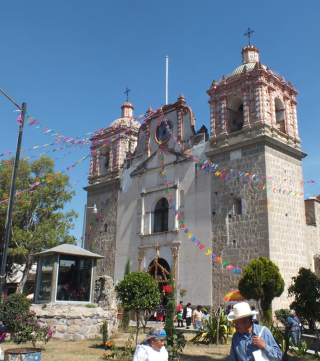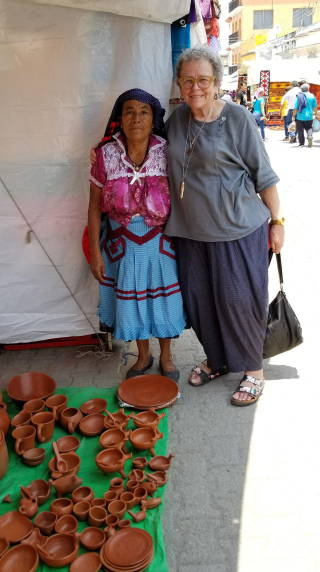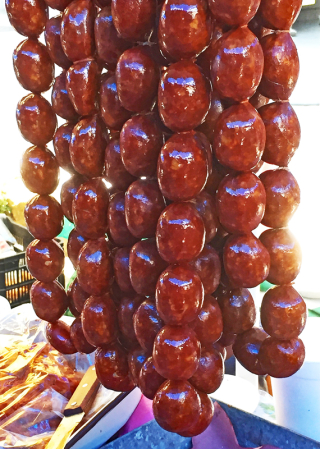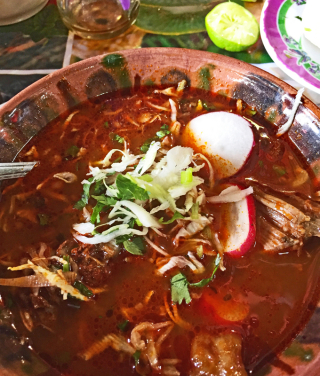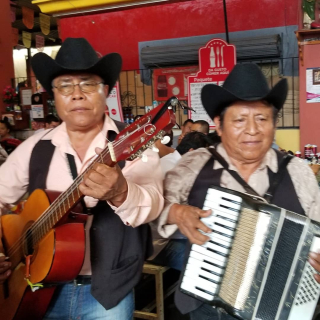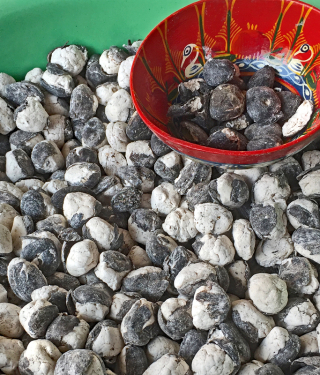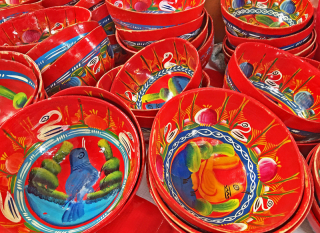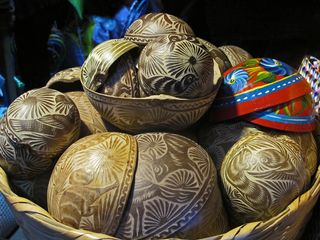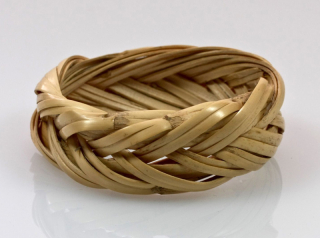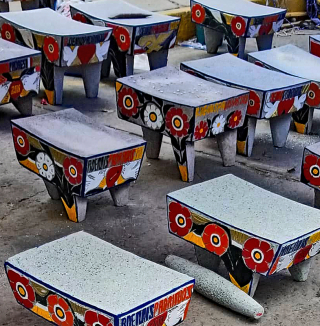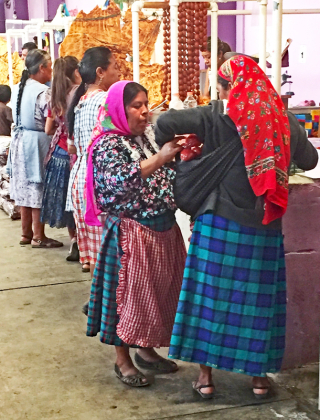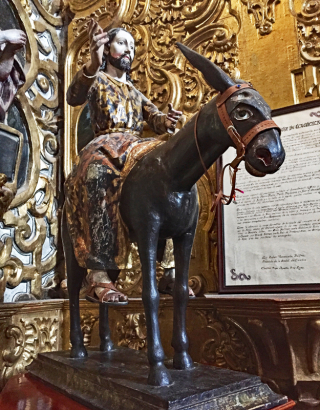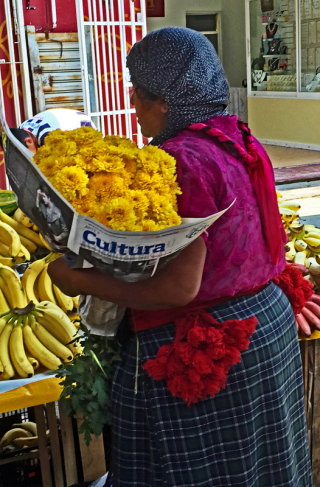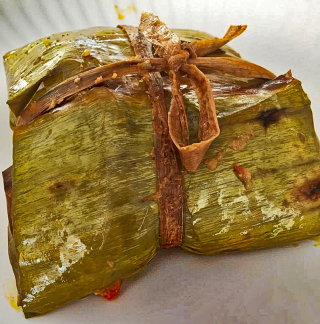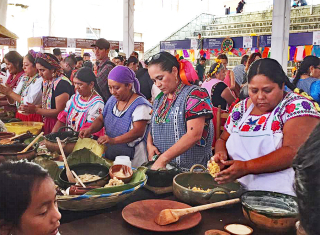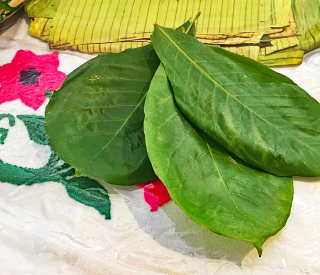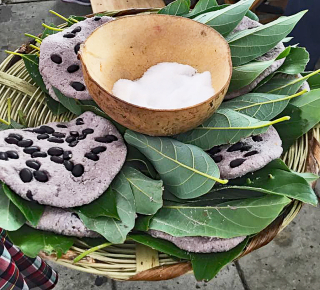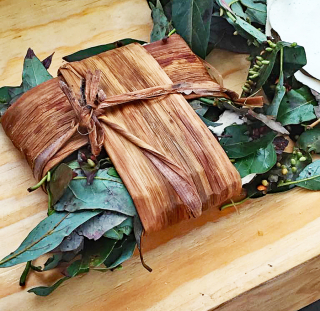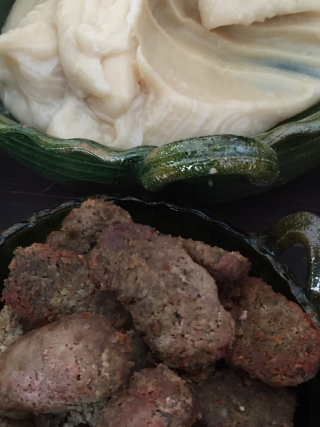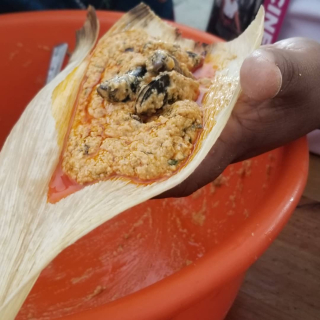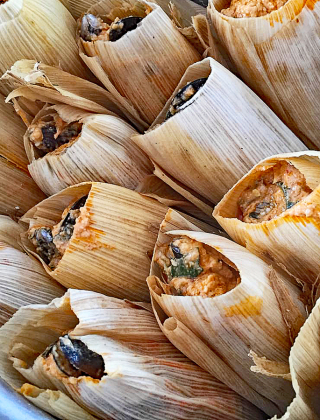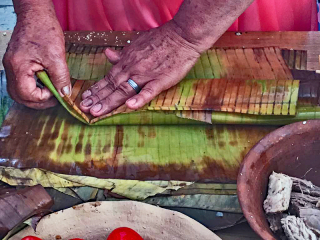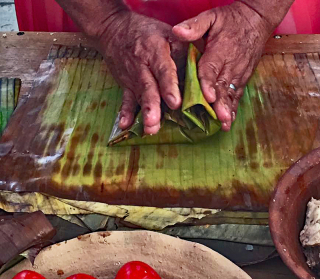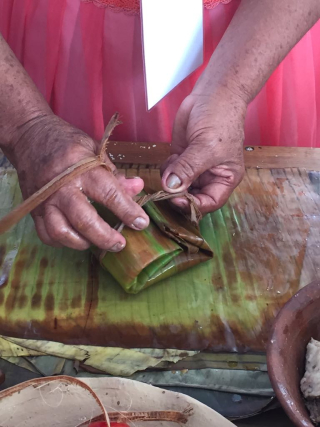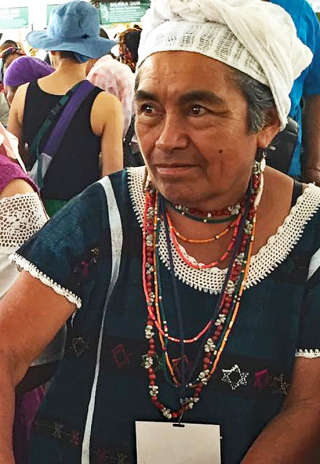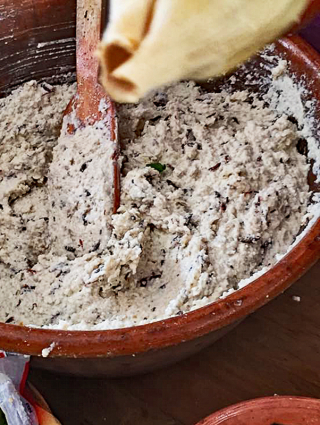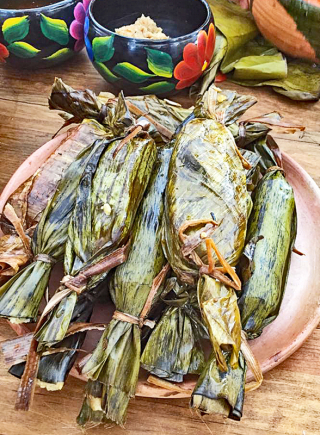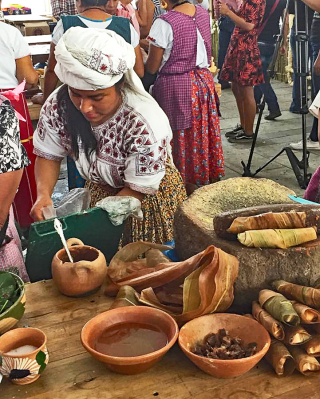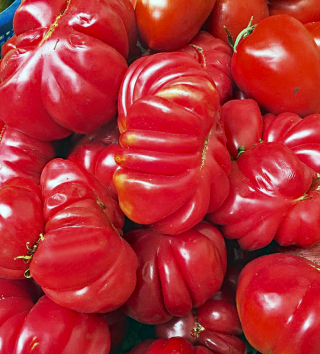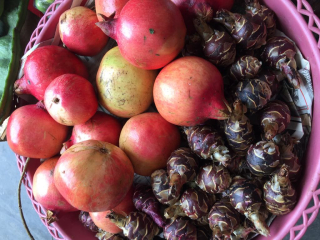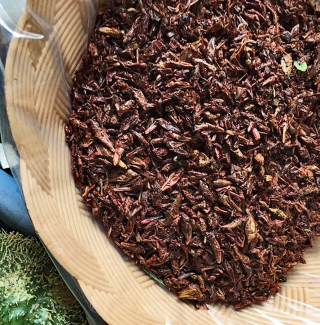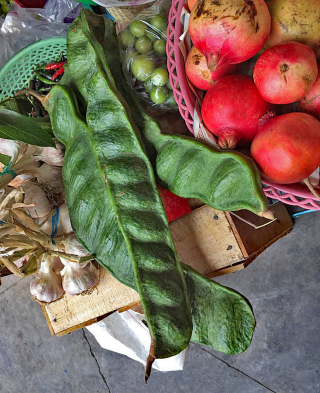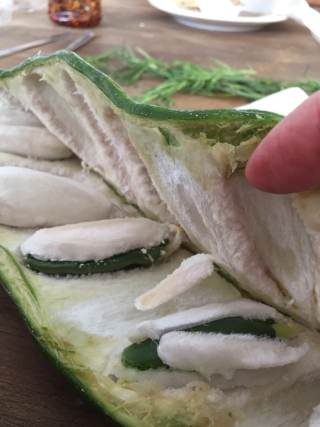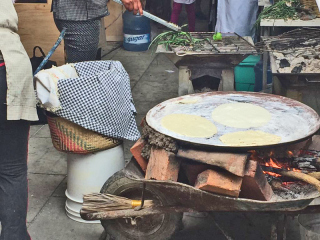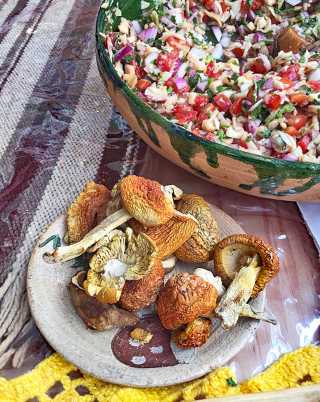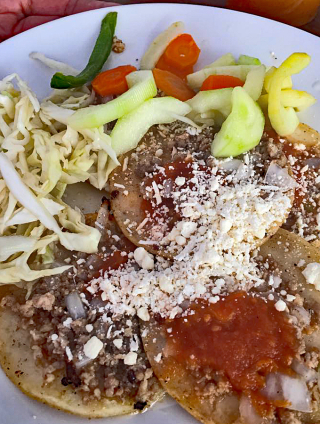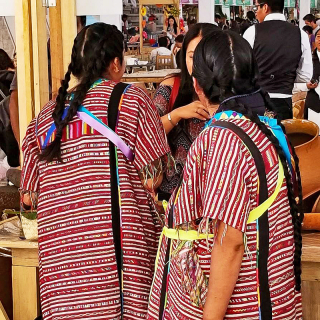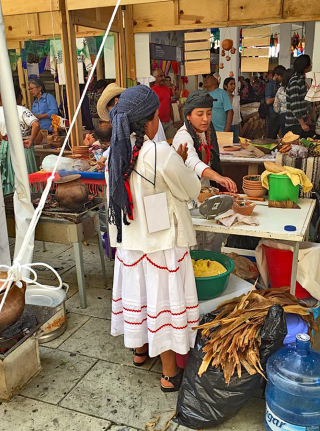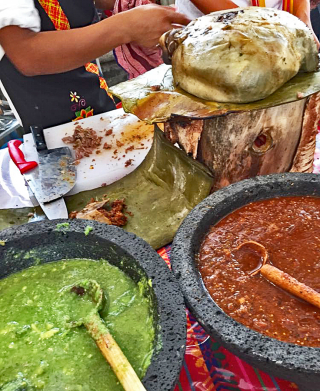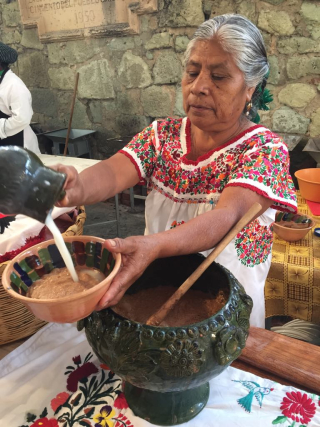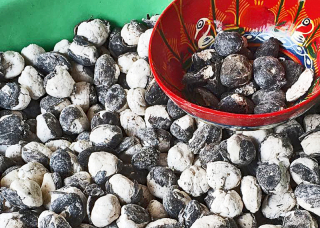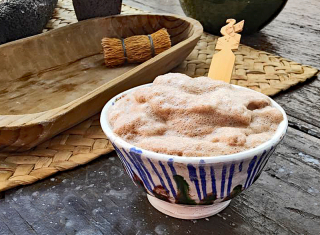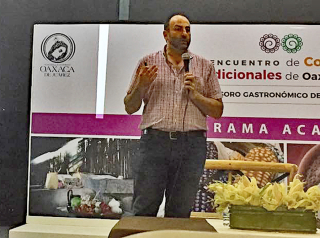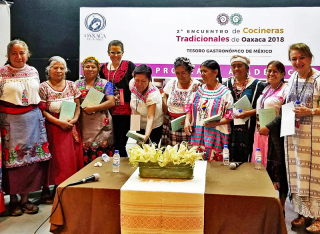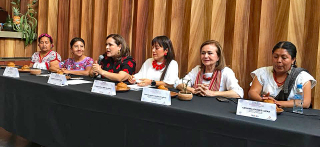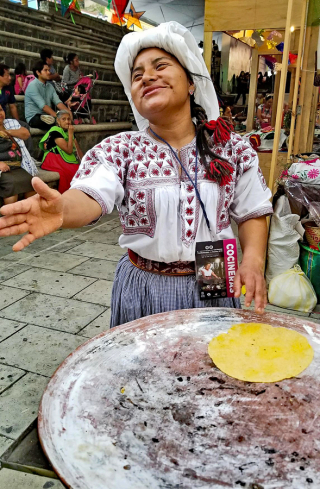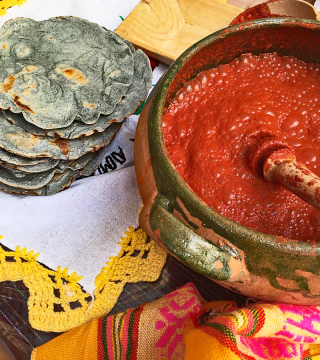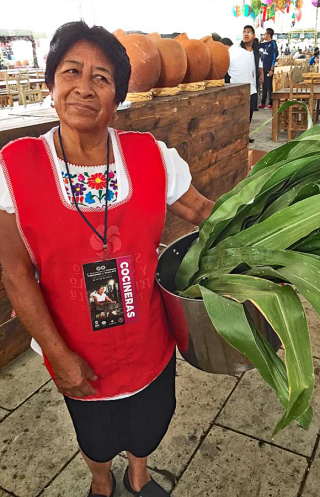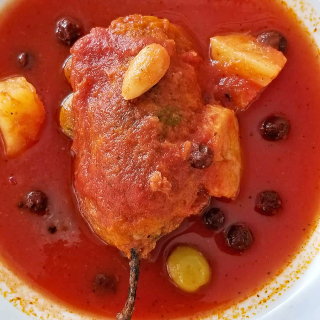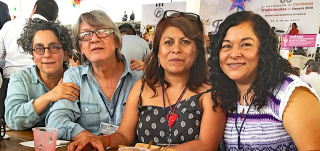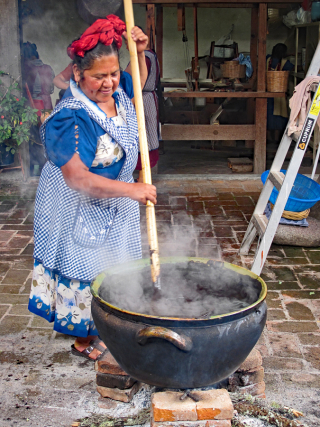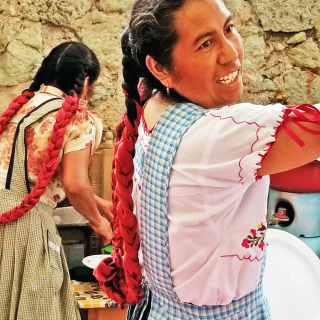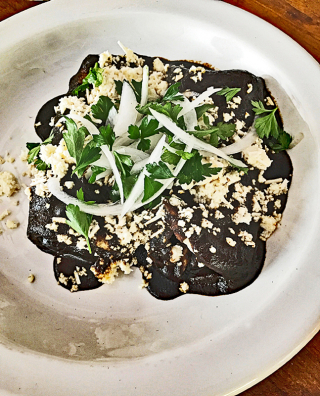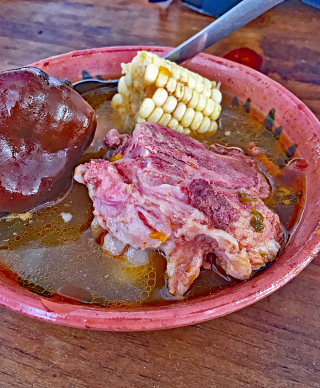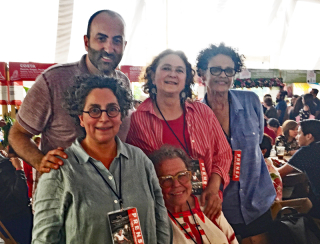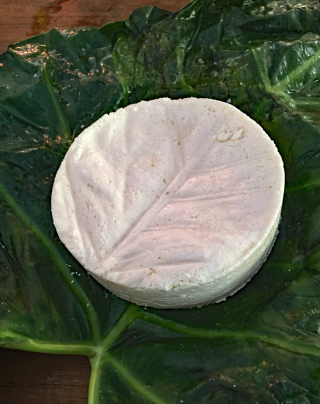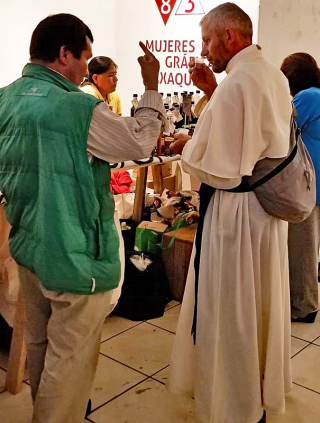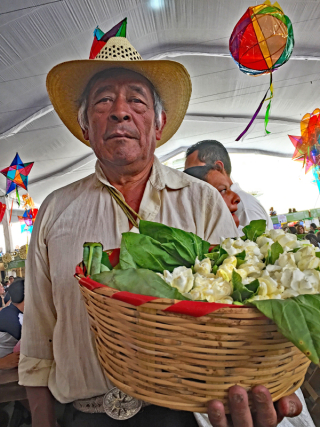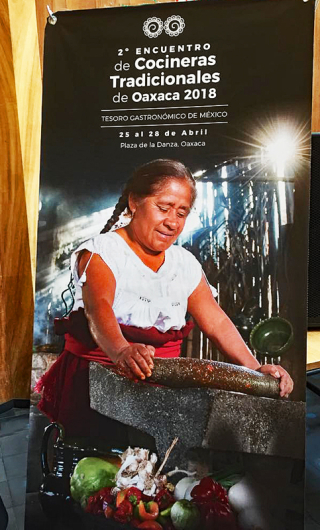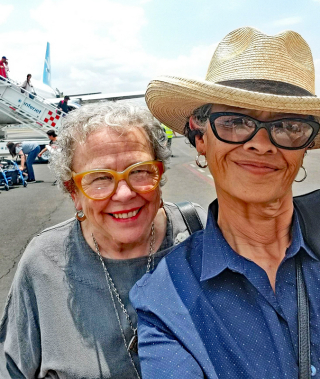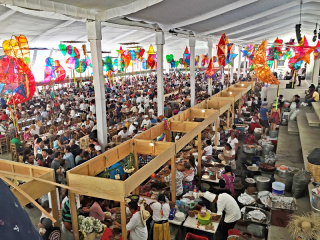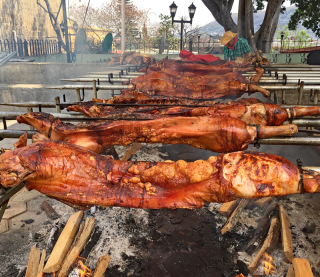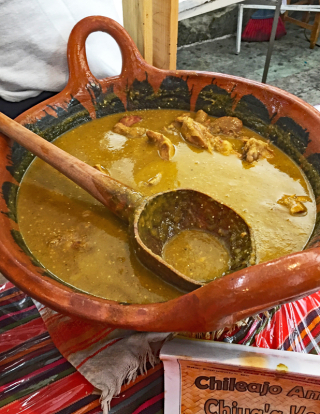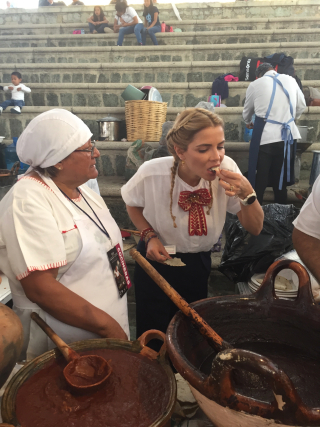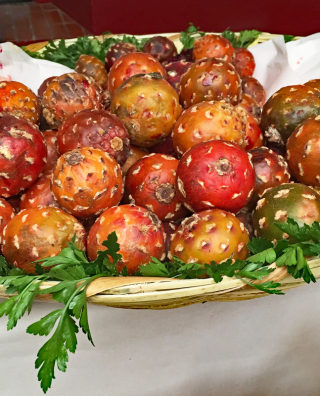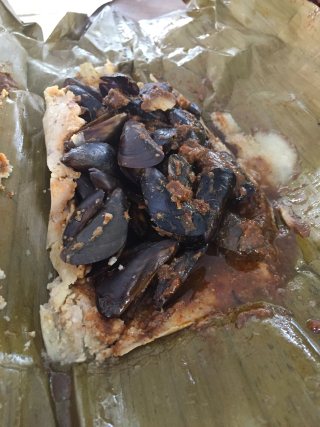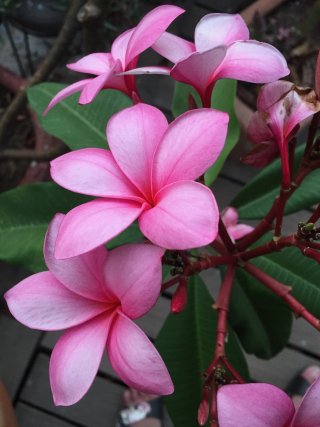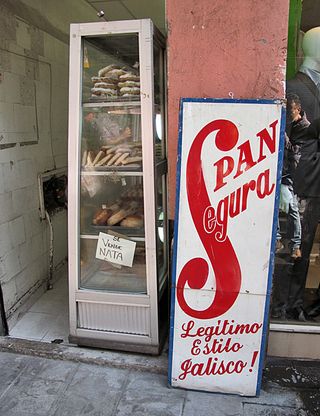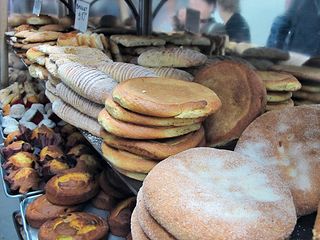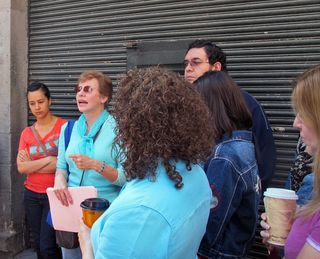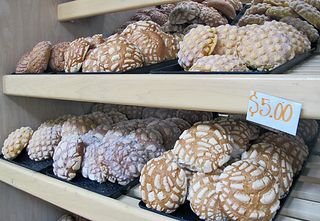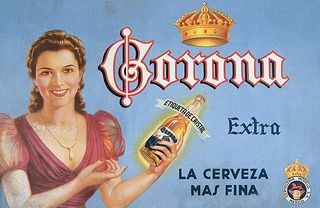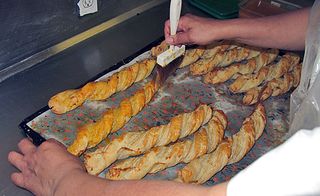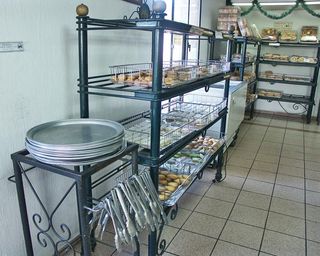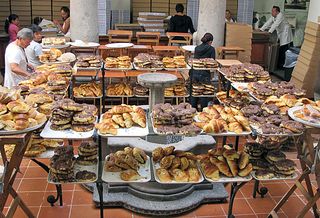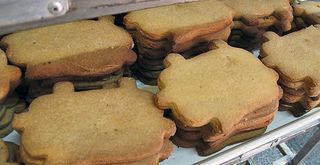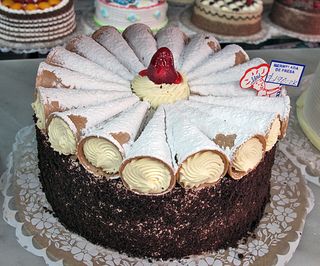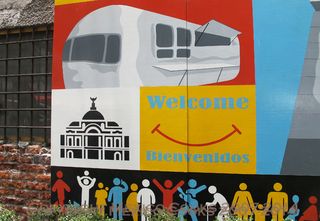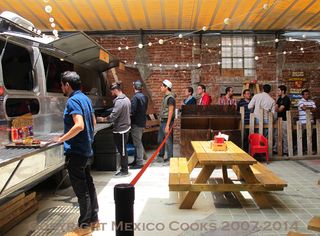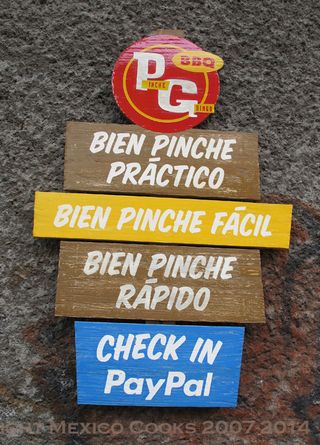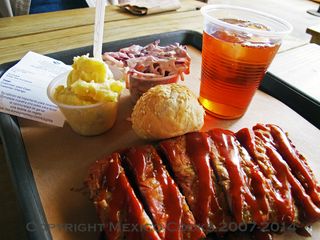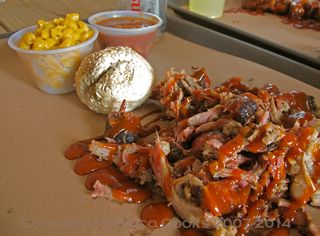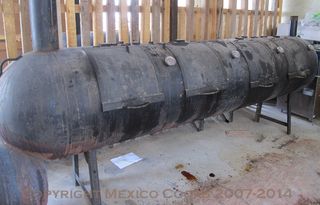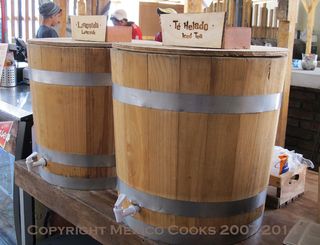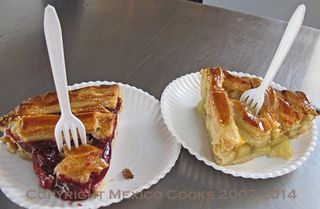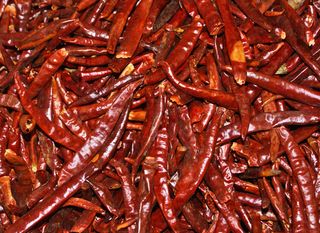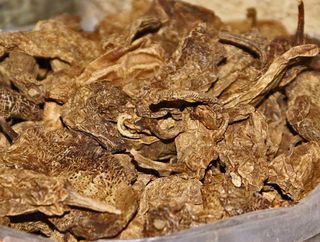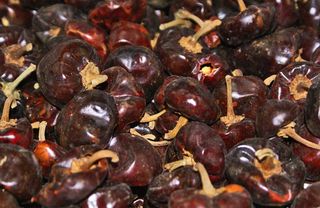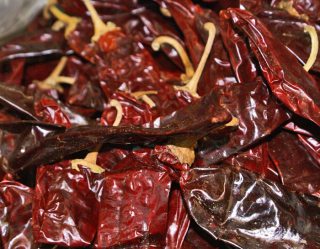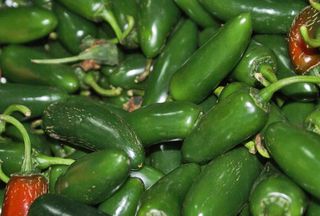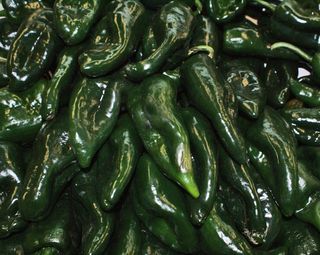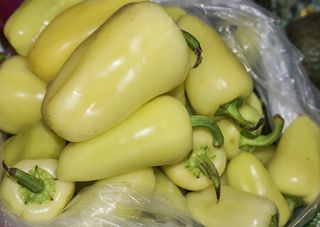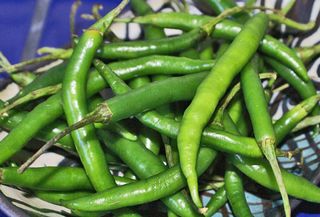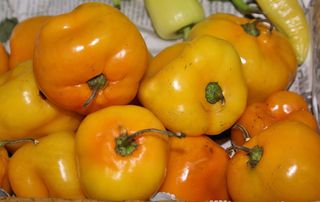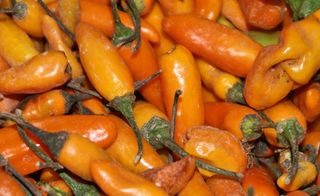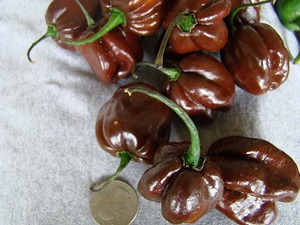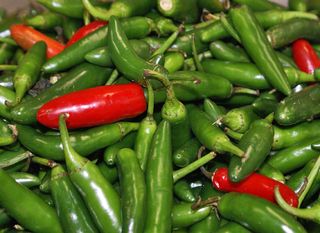
Along the 2-lane highway between Tlacolula and the Isthmus, Chef Silvana and I stopped to have the gas tank filled. (In Mexico, a gas station attendant performs that chore. There's no self-serve here.) In a little nicho between the men's and women's bathrooms, this figure on his miniature golden throne caught our attention. El Niño Dios de Pemex patiently awaited a visit from anyone who cared to visit him. He looks very sweet in his Pemex uniform–compete with company patch!–and straw hat.
Entering the city of Tehuantepec, this sculpture of a tehuana–the symbol of the region–greeted us. She's dressed in full tehuana vestido de gala, including her resplandor, the lace headdress.

Another sculpture of La Tehuana, with a silver over copper mask and resplandor of actual lace, electroplated with silver. Work of Mexican sculptor Ana Pellicer, Santa Clara del Cobre, Michoacán.

A glorious hand-embroidered made-to-measure velveteen huipil (regional Istmo de Tehuantepec blouse) created by fabulous costurera (seamstress) Sra. Nancy González at Taller Bizuudi, 16 de septiembre #99, Ixtepec, Oaxaca. That's her handsome son behind her. The highly colorful embroidered huipil (blouse) and its companion enagua skirt, the characteristic dress of the women of the Istmo, are available in a range of quality and price in the markets and shops of the Istmo.
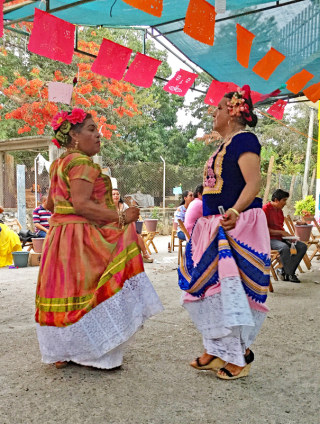
Here's a good look at the traje de gala (fancy dress) of the tehuanas–the women of the Istmo de Tehuantepec. Chef Silvana and I were invited to this dance–more about that in a minute!
The Isthmus (Istmo, in Spanish) of Tehuantepec is the largest region in the state of Oaxaca, connecting the southwestern part of the state of Oaxaca with the western part of the state of Chiapas. Part of the Istmo is on southern Oaxaca's Pacific Ocean coast, part is inland to the north and east. Prior to the building of the Panama Canal, the Istmo was the shortest land trade route between the Pacific Ocean and the Gulf of Mexico; if you look at a map of Mexico, you'll see that the Istmo is the narrowest part of Mexico's "waist". Fairly distant from more populated parts of Oaxaca, the Istmo has its own cultures, its own manners of dress, and its own foods. Several distinct indigenous groups live in the Istmo, each with its own language.
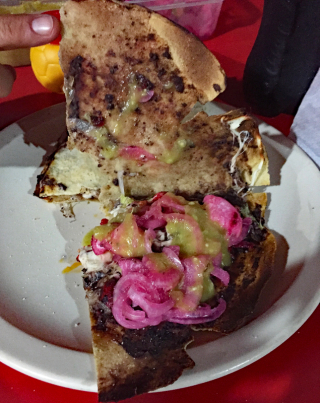
The first night we were in Tehuantepec, we enjoyed wonderful tlayudas at Cenaduría Juanita, an outdoor supper stand near our hotel. The tlayuda is one of the iconic foods of Oaxaca; made from a very large corn tortilla (actually called tlayuda), the dish can be eaten for desayuno (breakfast), comida (Mexico's main meal of the day), or cena (late-evening supper)–or any time in between! These were absolutely wonderful, maybe the best tlayudas I've eaten.
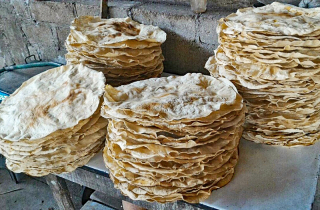
Here are a lot of tlayudas–the simple tortilla–pressed, toasted, and ready to be prepared as tlayudas–the meal. These measure about 13-14" in diameter. Each one will be spread with asiento (the delicious brown fat at the bottom of a pot of newly rendered pork lard), then layered with smoothly blended black beans, then with tasajo (seasoned semi-dried beef) or cecina (seasoned semi-dried pork) or chorizo (spicy pork sausage) or even with shredded chicken. Then one adds shredded quesillo (you might know it as Oaxaca cheese), then shredded fresh cabbage, slivers or slices of green chile (either fresh or pickled), sliced tomatoes, sliced avocado, fold it in half, and toast it on a griddle or a grill till the cheese melts. Add the salsa that you like best and get your mouth ready for a taste of heaven. Any tlayuda recipe is very forgiving: add this, leave this out, put more of this or that, add (as in the picture above this one) pickled red onions, turn your avocados into guacamole and add that. However you prepare them, the only "requirement" is that you start with that freshly toasted tlayuda base.

Chef Silvana holds a memela. A small, freshly toasted tortilla is the base for a smear of asiento, a smear of creamy black beans, maybe some tasajo or cecina, a lot of queso fresco (fresh crumbly white cheese), some sliced avocado, and then topped with either red or green salsa. These Oaxaca-style memelas are usually about four inches in diameter.
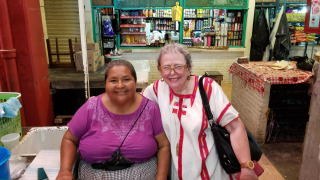
The next morning, we went to the Tehuantepec market to see what it had to offer. Mid-market, we met the delightful María del Carmen Suárez, who sells her famous home-made budín (in this case, a type of flan that she makes with breadcrumbs) and her excellent pickled vegetables. We spent quite a while chatting with her; she sells at the market several days a week. She did tell us that she'd be working the following day, but not the day after that. We didn't ask why, but we later found out. Remember that photo (up there ^^) of the tehuanas dancing? The plot thickens.

María del Carmen's budín. It was very good, with no indication of bread crumbs in its texture other than a pleasantly slightly thicker consistency than normal flan.
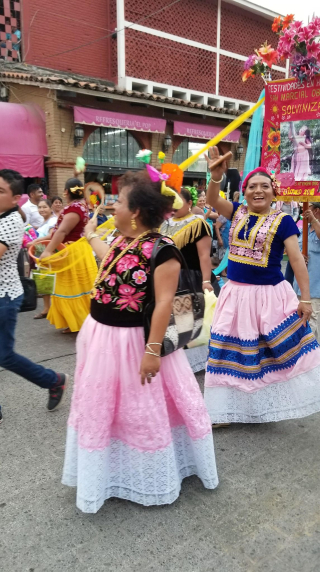
So: the surprise! Silvana and I had been out the entire day, driving among several small towns around the city of Tehuantepec. Mid-evening, we pulled back into town and parked, intending to go find something to eat. Wait–music! Drums! Shouting! Flags and banners! What's that coming toward us? A PARADE, and not just any parade–dancing down the street came a contingent of laughing, shouting muxes, the "third sex" of the Istmo world. Much associated with the city of Juchitán, muxes also live and work–and play–in Tehuantepec. These gorgeous creatures beckoned to us: "Vénganse! Vénganse! Vénganse con nosotras al Baile del Barrio!" ("Come on! Come on! Come with us to our Neighborhood Dance!") We scurried out into the street, linked arms with some of the beautiful muxes, and paraded through town, backed by flags, banners, flowers, and music.
A few blocks outside Tehuantepec's Centro Histórico, we were led to a blocked-off street covered with a lona (tarp), decorated with papel picado (cut paper streamers), and alive with joyful, dressed for the gala muxes, their companions, and people handing out plates of food, pouring tequila, passing around bottled beer, and hugging everyone who came along–including us. We were invited to sit down, invited to eat, invited to drink. And then, shouts of, "A bailar! A bailar!" ("Get up and dance! Get up and dance!")

And suddenly we heard a scream: "Amigaaaaaaas! Amigaaaaaaaas!" We turned around to see–María del Carmen, from the market! She grabbed both of us and hugged us hard. "AMIGAAAAAAS!" So this was why she didn't work today–she had to get ready for the Baile del Barrio! "María del Carmen, why didn't you tell us the other day?" "Bueno–bueno, I wasn't sure…" We laughed and hugged and were so glad that we actually had met someone before who was at the dance. She looked beautiful, in her traje de gala.
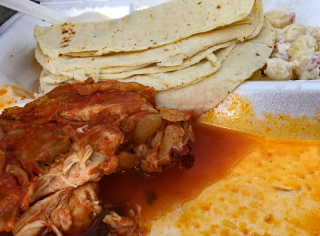
Our delicious dinner: Tehuantepec-style chicken in a flavorful, spicy sauce, served with macaroni salad and a pile of tortillas. "Is that enough? Do you want more chicken? More tortillas? Another beer? Wait, here's another shot of tequila! No, wait, let's dance first!" The people at the dance made us feel entirely welcome and totally at home.
[youtube=https://www.youtube.com/watch?v=PUUI3NXBU9Y&w=420&h=315]
We had the best time ever!
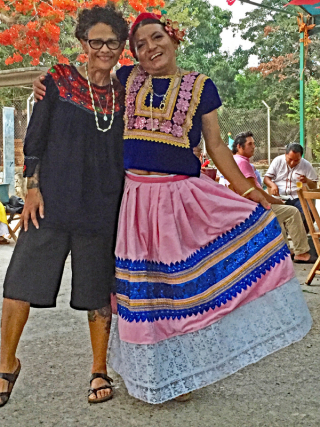
EVER! I'm grinning ear to ear just looking at these pictures. Such sweet, beautiful memories we made, all of us together.
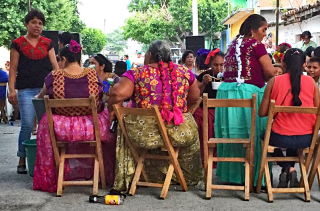
Beautiful young women, beautiful older women–nothing separated us during this magical evening. I know for sure that the next time I go to the Istmo de Tehuantepec, someone will scream out, "AMIGAAAAA!" and she will be a friend from this night, connected by the joy of music, dance, and by our shared experience of a chance encounter that meant the world to all of us.
Next week, further travels and surprises around the Istmo. Come along! Get up and dance!
Looking for a tailored-to-your-interests specialized tour in Mexico? Click here: Tours.
